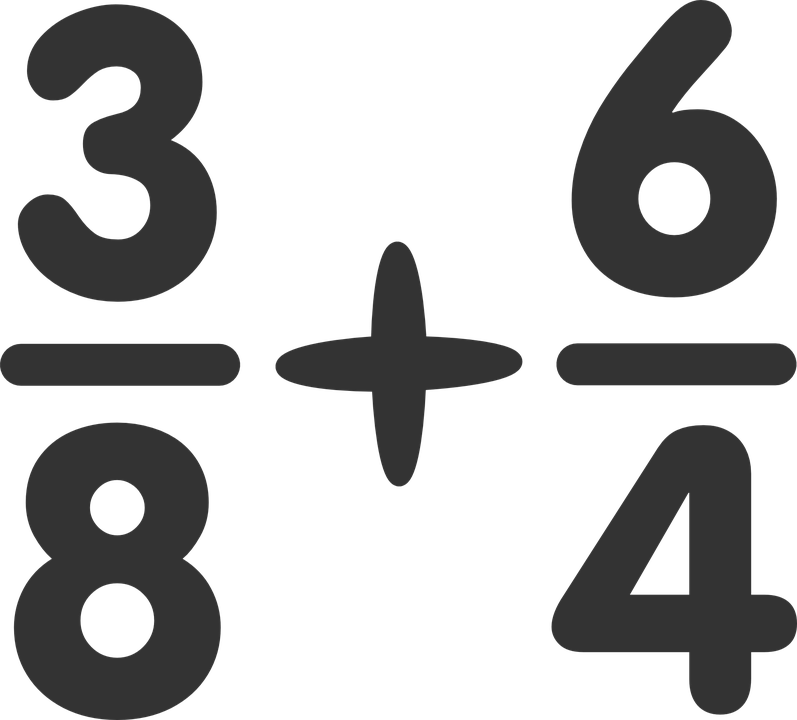The operations with fractions correspond to one of the challenges that we must address during our school years. Only the second step in a long journey through mathematics that begins with the natural numbers and operations as simple as adding, subtracting, multiplying or dividing. Once we have been able to consolidate this type of concepts, we will have to face the dreaded fractions and their different exercises.

For this, it will be necessary for us to be able to understand the equivalence of these mathematical terms through the least common multiple, and later the rule that is applied to carry out the same operations that we already carry out with the natural numbers, but in this case with the fractions. If we want to continue progressing in the mathematical world, it will be necessary to master this type of operations because in more complicated situations such as equations or logarithms we can also find the use of fractions.
What are fractions?
When we look at a fraction, the first thing that comes to mind is two numbers separated by a suit. If we take it to real life, it would be the division between two natural numbers. In fact, it is equivalent to dividing the top number by the bottom number and taking the decimal as the fraction itself. Even one more step to facilitate the reading of this fraction, we can carry out this division and, later, multiply the result by one hundred to obtain the percentage. It’s easier to read 50% than not 1/2, but in mathematical terms it’s totally equivalent.
The fraction itself is divided into two parts. For one, the top number is known as the numerator while the bottom number is the denominator. These two numbers are separated by a line that serves to separate the two parts of the fraction itself. Let’s not forget that at a colloquial level we can affirm that a fraction serves to express the portion of a part. Let’s say we have 1/4. If we are looking at a pizza or a cake, two dishes that are usually divided into portions, 1/4 would tell us that if we divided the plate into four parts we would have one, that is, 25%.
Mathematicians also establish different rules for fractions that we need to know. The expression that divides these mathematical norms is A/B. A is the numerator while B would be the denominator. In this case, A can be an integer, while B needs to be a rational integer. For example, 0 can be a numerator since any number that acts as a divisor will always be 0, which is a possible operation. However, 0 can never be the denominator since it is not possible to divide a number by zero since it would be a non-rational operation. You can’t divide two apples by 0 apples since it’s something that doesn’t make sense and it’s not possible to happen.
In addition, it is also important that you know the different types of fractions that we can find. On the one hand, when both the numerator and the denominator are real numbers, we would be facing a type of simple fraction. Within this typology, we can distinguish between proper fractions when the numerator is greater than the denominator, and improper fractions when the denominator is greater than the numerator. Beyond simple fractions, we also find other types of fractions such as mixed ones in which different concepts are mixed.
On the one hand, we are talking about a proper fraction since the numerator will be greater than the denominator, but an integer must also appear. With an example, this will be understood in a much simpler way. For one, we start with a fraction that will be 30/20. As we have said before, equivalent fractions are those in which two mathematical expressions express the same value. In this case, 3/2 is the same as 30/20, since only the two zeros have been simplified. If we continue dividing 1 multiplied by 1/2 it would be another similar expression. This would be a mixed fraction since it mixes the whole numbers with the fractions. Finally, inverse fractions are all those in where both the numerator and denominator can be reversed.
Benefits of knowing how to subtract fractions
All in all, there are numerous benefits of knowing how to subtract fractions and operating with these types of terms in the mathematical world. Some of the most prominent are the following:
- Operate with portions. Fraction operations are basically with portions of an object. If we transfer the language of fractions to the real world, we will find that basically we operate with portions of different objects.
- Pass math. If we are capable of mastering fractions, we will have no problem passing mathematics and moving on to the next course. They are usually located in the fifth and sixth grade academic program in Spain.
- Being able to continue progressing in the mathematical world. As we have said before, mathematics is like building a house. Therefore, if we want to face more complicated challenges, we must be able to master fractions.
- Carry out a hobby. We will put into practice a hobby like mathematics if we are one of those who loves mathematical problems and loves to give the coconut to find the answer to the different challenges.
How to subtract fractions?
Once the different types of fractions are known, it is also important to know the different options that we have at our disposal to operate with fractions. One of the most basic operations that we can find is the subtraction of fractions. It is similar to the subtraction of integers, but with the main particularity that a series of equivalences must be met before carrying out said operation. This is known as the least common multiple. The first step to solve any type of fraction is that they have a common denominator. Without it, it is impossible for the operation to be resolved correctly. The least common multiple is defined as that number that encompasses all the factors of the denominators. How is it obtained? In a really simple way. Let’s take the example that we have 1/5 and we have to subtract 1/2. First of all, as we have said before, it will be necessary to establish a common denominator.
As they are primary numbers, the factor that encompasses the two factors is 10, product of the multiplication between 5 and 2. Therefore, the denominator of both fractions will be 10. Once we have this denominator, we must take the common denominator, divide it by the initial denominator and multiply it by the numerator. Therefore, in the first case we will have 2/10 left and in the second fraction it will be 5/10. Therefore, when we subtract 2-5 we get -3. The final result will be -3/10. In this case, the common denominator has been the product of the denominators because they were two prime numbers, that is, those that can only be divided by one and themselves.
Let’s take another different example. Now we have to subtract 3/6 and 2/3. In this case, the result of the least common multiple is 6. Basically, because the three is already included in the six. Once we have the common denominator we repeat the same operation that we have done before. The first fraction stays the same since dividing six by six gives one, while in the second case the result is 4/6. Therefore, if we finally carry out the operation with the natural numbers, the result will be -1/6. What sense does this result have in real life? Let’s say there are two pies.
One has 3 parts of one of six and another has two parts of three parts. The difference is that the first has a portion less than the second. It is important to know how to interpret these types of problems since in most cases it will be necessary to transfer them to the language of fractions before solving them. Therefore, it is also necessary to know how to pose the problem before solving it correctly by applying the methods that have been previously exposed.
The calculator, our best friend to solve fractions
However, technology offers us other ways to solve fractions without the need to perform operations naturally. To do this, it is only necessary to pull a calculator or Microsoft Excel. Although it is important to know how these types of operations are carried out, we will also explain other types of methods that you can surely use when you have little time. Using the calculator is a quick and easy procedure.
You only need to put the numerator as the first number, then press the L-shaped button that means the division between the two fractions and finally the second number that would become the denominator. Thereafter, we press the subtraction button and do the same with the second fraction. Finally, pressing the equals we will obtain the final result of the operation. For this type of system, Casio scientific calculators are worthwhile since they have enormous precision and allow us to carry out these different operations without any type of difficulty.
On the other hand, Excel spreadsheets are also an excellent option for subtracting fractions without any difficulty, and quickly and effectively. However, one of the best systems that we can use is the natural one to learn to carry out the procedure with the binary system.
